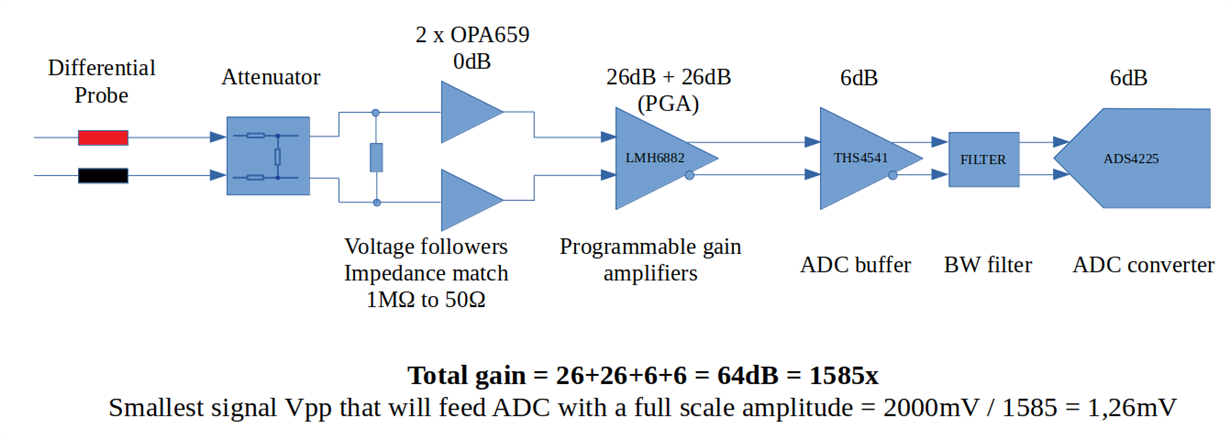Other Parts Discussed in Thread: LMH6882, THS4541, , LMH6881, OPA659, LMH6518, OPA859, TINA-TI
Hi, as you know this ADC has no internal buffer and therefore i have to find one myself. I have been looking at oscilloscope front end ideas during the last days and it is really tricky to find the right candidates.
I want the coupling to be DC & AC so the use of transformers is not an option. I want the smallest input signal to be 10mVpp which, considering 2V of the ADC's max input, means 200x or 46dB.
I liked the LMH6882 in a cascaded topology resulting in a max gain of 26dB*2=52dB which, considering the additional 6dB ADC programmable gain, is more than i want but seems fine given that i can use SPI to set the value that i need. Also in a previous question of mine you proposed THS4541 which seems like a match for the common mode voltage (is it?).
Now, the ADS4225 needs a common mode voltage of 0.95V (+/-0.05V) so that the common mode voltage is exactly centered in its' dynamic range thus receiving a symmetrical waveform with zero-offset will evenly utilize the ADC's dynamic range. That however requires that the buffer opamp needed must be able to operate at that common mode voltage. I know that usually these opamps have an input that is directly connected with the ADC's common mode voltage output pin so that we can have an exact match and therefore avoid unpleasant conditions.
Considering a fully differential buffer for the ADS4225, i saw LMH6882 as i said earlier. Unfortunately the common mode voltage output of this opamp is not anywhere near 1V (0.95V) that the ADS4225 requires. Instead, as page 22 (at the top) suggests, common mode voltage at the output of the LMH6882 is 2-3V (input CMV pin 1-1.5V + 6dB gain). On the other hand, THS4541 seems closer to the CM requirements.
Could THS4541 be used as a direct buffer for the ADC and LMH6882 be driving the THS4541?
I am a bit confused as to which opamp would be the proper candidate to drive this ADC while satisfying CMV requirements of the ADC.
The basic schematic of the DSO front end that i was thinking about is this. The probe will be differential (of some kind).
*I off course understand that noise of every stage must be calculated and eventually the total noise. Given the 1.26mV smallest signal that i have calculated, there will probably be lots of noise but i am not planning to go that low.
Can you pls help?
Regards
Manos Tsachalidis





